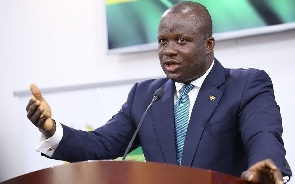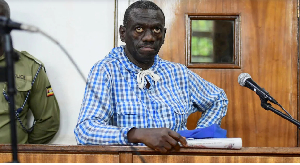A ten-member committee has been constituted to examine earthquakes and tremors in Ghana and draw up a framework for refocusing on preparedness and response.
The Ghana Geological Survey Authority (GGSA), which has also been tasked to revamp the digital seismic network real-time monitoring for early response, is working with relevant agencies to revamp the national seismic network and early warning systems to provide real-time monitoring and information.
Minister for Lands and Natural Resources, Samuel Abu Jinapor, disclosed these in Parliament on Wednesday in a statement he read on the earth tremors that hit parts of Greater Accra on December 12.
The epicentre of the tremor was located around the Weija area, between Wiaboman and Bojo Beach, about 575m in the territorial waters of Ghana from the baseline of the sea.
The impact of the tremor was highly felt in Dansoman, Mateheko, Weija, and surrounding areas while areas far from the epicentre, such as Legon, Amasaman and Accra Central, including the Ministries, Parliament House, the Court Complex and the Supreme Court, also felt the impact and temporarily brought business activities in these areas to a halt.
The Minister indicated earthquakes and tremors are not new to Ghana with the most serious occurring in December 1632, July 1862 and June 1932.
“Since then, several moderate to minor earthquakes and tremors have occurred in various parts of the country, with two occurrences last year, in Bortianor and Kpando, the most recent ones before this month’s occurrence,” he added.
According to him, seismicity map of the country shows the south-eastern parts of the country that falls within the West African mobile belt is most prone to earthquakes and tremors and added, “Unfortunately, over the years, we have not invested enough in seismic monitoring to determine such occurrences in real time.”
“The first seismic instrument in the country, a Milne’s single-boom seismograph, was installed in 1914 and operated until 1937, when readings were discontinued on financial grounds.”
“The country operated without a seismic instrument until 1973, when a Geotech Long Period Z Component Seismograph was installed in Kukurantumi to record distant earthquake events.”
“Threats of earthquakes in the country compelled the then Government to install an analog seismic network in 1987 to record various levels of local earthquakes in the southern part of the country, but this instrument is outmoded and no longer operational.”
According to the Minister, there are currently eight network seismic monitoring stations located in Akosombo, Asankragua, Ho, Kukurantumi, Lake Bosomtwi, Saltpond, Shai Hills, and Weija and connected to the National Seismic Observatory at Achimota by satellite transmission to provide real time data on earth movements.
He lamented, however that the satellite transmission has not operated optimally making it difficult for the GGSA to provide real time information and advice on earthquake and tremors.
Mr. Jinapor disclosed that government is discussing with Nanometrics Incorporation of Canada, manufacturers of the existing monitoring equipment to convert the satellite system of data transmission to cell modem transmission using local telecommunication sim cards.
This, he said, has proven to be more reliable and easier to operate and indicated the Lands Ministry is working with the Ministries of Finance and Communications and Digitalization to facilitate and expedite this transition.
He assured the Akufo-Addo government does not take the safety and security of Ghanaians for granted and is fully committed to resource, retool and position the GGSA to deliver on its mandate particularly, as it relates to the monitoring of seismicity, earthquakes, tsunamis and other natural disasters, as well as geo-hazard mapping and public education on geo-hazards to enhance the capacity of the nation to mitigate and reduce the impact of natural disasters and risk.
General News of Thursday, 22 December 2022
Source: Ministry of Lands and Natural Resources

















